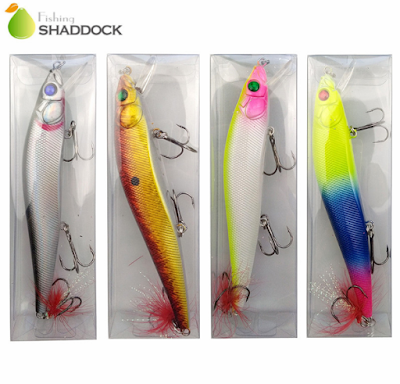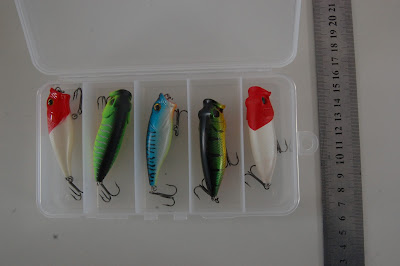If you want to have a trip of topwater bass fishing, the most important thing is to choose the right topwater lures. There
are many kinds of topwater fishing lures in the tackles store, so it is very
difficult to simplify your selection process. If you don’t want our effort in
vain, you’d better consider the advices of the experienced people.
We usually divide the topwater lures into following
types: walkers, poppers, wakebaits, minnows baits, prop baits, buzzbaits
and frogs. Different types are suitable for different conditions, today we will
talk about the topwater walking and topwater popper, and they are the most
common lures people use in the topwater fishing.
1. The walkers of topwater fishing
Topwater
walking baits have a slender baitfish profile, and move in a sashaying, “back
and forth” action referred to as “walking the dog.” They create a tremendous
surface commotion, and draw interest from bass at a great distance. For that
reason, they are ideal when you’re fishing in open water areas, and any time
you need to cover water to locate feeding bass. They are also ideal for
targeting schooling bass, as they can be cast a mile and fly straight every
time.
As we have
said before, different types are suitable for different conditions. You can use
a walker under the following conditions:
1) When the bass you fish are big: Walking topwaters are very
effective
when
you catch the big bass, because they are the great bait for big bass.
2) When the water is calm: Walking baits are
best in slick or slightly rippled
water.
Big noise will spook the fish in the calm water, walking topwaters usually have
a more subtle, gliding action and can make less noise.
3) Schooling bass: When you see bass schooling
in open water and blowing
up
everywhere, you need to have a walking bait in your hand. They cast so much better than others, so you
can reach fish 40 yards away from you. They also emulate a fleeing shad very
well, which triggers a schooling bass’ instinct to attack.
2. The Popper of topwater fishing
Topwater poppers
feature a flat or concave face, and a baitfish profile. By twitching and
jerking the rod, these topwater baits create a splash and popping sound that
drives bass crazy. Because they are most effective when worked relatively
slowly, poppers are ideal for target fishing in shallow water. They can also be
casted very accurately, which means they are easy to place gently next to a
stump, laydown, or grass line.
The appropriate scenarios of using a popper
are:
1) When you want to catch the bass for numbers: Topwater
poppers will
catch
a lot of bass in the fall when other presentations fall short, you’ll still
catch a big one every now and then, but it’s a great option for filling your
limit.
2) When the water is choppy: In the windy days,
the water is choppy, and it
you
still use thewalking topwaters, it will be hard for the bass to see the lures .
Poppers can help the bass know exactly where the lure is.
3) When the water temperature is decreased: When
the water temperatures
dip
down into the low 60s or high 50s, it’s hard to beat a popper. The bass aren’t
as active in this temperature range, so a slow presentation is essential. You have
to be patient because some of your best bites will come on a long pause.
Here are
the main difference between the walking topwaters and poppers, and I think you’d
better prepare both of them at home, and experience the different styles of
topwater fishing.
Facebook
Twitter
Google+
Youtube
Pinterest



没有评论:
发表评论